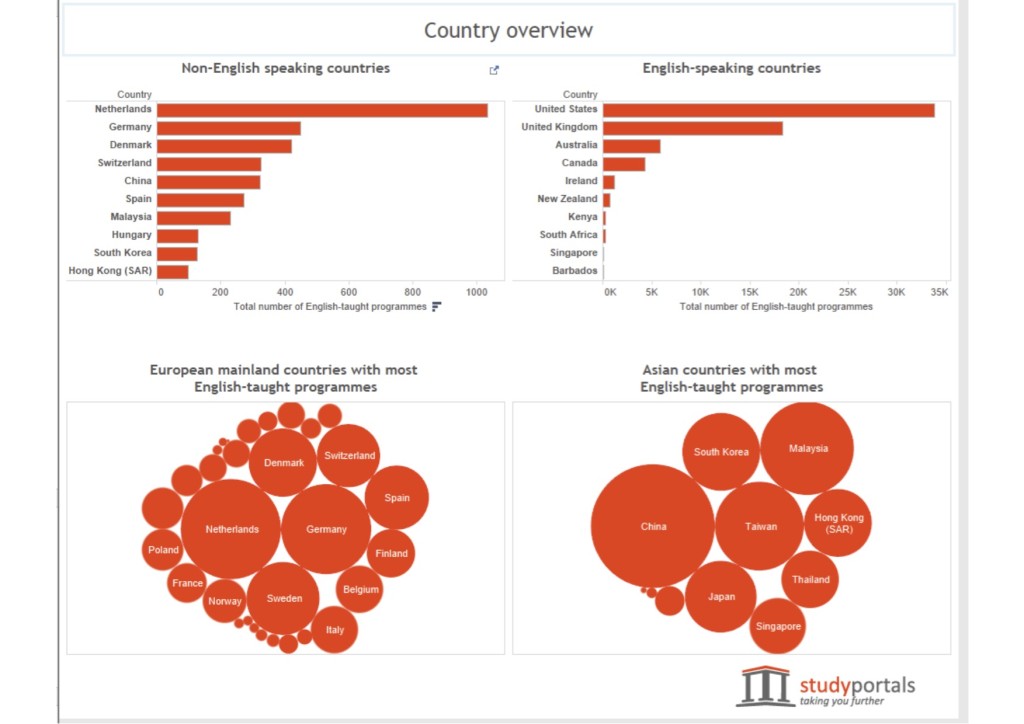ONE of the big education stories of our times is the drive towards ‘internationalisation’ by universities all over the world.
I’ve written about this already this year for BBC online news and EUPRIO, the European Universities Public Relations & Information Officers.
One thing standing out is the rush to create courses entirely taught in English all over continental Europe and now in Asia, Africa and beyond.
For EUPRIO, I looked specifically at the incredible rise of nearly 1,000% in the number of English-taught programmes, or ETPs, offered by universities in non-English speaking European countries since 2002.
For the BBC I highlighted a new report and interactive map from Dutch-based Studyportals, which found almost 8,000 courses being taught in English at top universities in non-Anglophone countries, including a growing number in China, Japan and Taiwan.
Growing trend
All this is part of the growing trend to entice international students, often paying hefty tuition fees, by teaching in the global language of higher education.
Along with attracting academic staff from abroad, getting students from other countries is seen by universities as key to their ‘internationalisation’ strategies.
But despite the impressive growth – with the Academic Cooperation Association (ACA) recording an increase in the number of ETPs in non-Anglophone European countries from 725 in 2002 to 2,389 in 2007 and 8,089 in 2014 – it is still estimated that only 2% of the world’s student population is studying in a country other than their own.
The ACA’s study, English-Taught Programmes in European Higher Education was produced by the ACA’s director Bernd Wächter and Friedhelm Maiworm from the Gesellschaft für empirische Studien, with help from Dutch-based StudyPortals and funding from the European Union’s Lifelong Learning Erasmus programme.
Most at Master level
It found that 80% of ETPs were at Master level, with just 20% at Bachelor level.
The Netherlands has the most English-taught university courses on the European mainland at 1,078, representing nearly 30% of their course provision. But other countries are catching up fast.
Germany had 1,030, according to the ACA survey, but this represented just under 6% of the total number of programmes available from the country’s universities.
Sweden had 822 courses taught in English – 24.2% of total provision.
The highest concentration of ETPs was found in Denmark, with 494 courses, representing 38% of the programmes available.
The most common motives for introducing English-Taught programme are removing language barriers to enrolling foreign students and improving the international competences of domestic students.
Putting things into perspective
The ACA findings also put the widely publicised ‘rush to English’ into some sort of perspective.
For despite the remarkable growth of studying abroad, only a small proportion of students across the European continent are enrolled on English-taught programmes in non-English speaking countries: The ACA puts the figure for 2014 at 290,000 students, just 1.3% of total student enrolment in the countries covered by their survey.
Interestingly, ETPs don’t just appeal to the world’s five million international students on the move as more students are choosing to stay in their own country and study in English alongside foreign students, particularly at master’s level.
Not just a European phenomenon
The expansion of English-taught university programmes is, of course, not just a European phenomenon.
In my feature article for the BBC Business News, I reported on a new initiative to help students find their way through the maze and discover the right course for them
The mapping exercise looks at what Studyportal describes as the ‘top 1,000 universities in the world’ using webometrics – which ranks universities according to their web presence and impact, said Carmen Neghina, StudyPortals Education intelligence specialist.
Of these, 763 of the top 1,000 institutions offer at least one or more ETP. This figure includes ‘top universities’ in English-speaking countries like the US and UK.
StudyPortals identified nearly 8,000 courses taught in English in what they describe as leading universities in non-English speaking countries, including programme offered by 45 universities in China. In Taiwan, they found 20 ‘top universities’ offering ETPs and 11 in Japan and six in Thailand.
So, whether it is home students in say Sweden doing a master’s taught in English in Lund, Stockholm or Uppsala or Chinese, Indian or Nigerian students studying alongside Dutch students in Amsterdam, Groningen or Maastricht in the Netherlands, the demand for ELTs is growing. And so is the supply, with experts estimating that the number of internationally mobile students wanting to study abroad likely to grow from five million to eight million between now and 2025.
LINKS
Universities compete by teaching in English, by Nic Mitchell (BBC business news, 3 February 2016)







